Our tutor had connections of some kind there, and so the six of us were met at the door by a very tall, thin woman who introduced herself to me by saying "My name is ________.* My great-grandfather was Henry Clay Frick, and he is responsible for the works of art you see around you."
I shook her hand and said, "My name is Franklin Habit. My great-grandfather dug coal in a Frick mine for most of his life, and so is he."
I am pleased to report that the august lady's response to this piece of impudence was a hearty laugh and an arm around the shoulder. Times do change.
The Fricks have their museum, and now my great-grandfather (and great-grandmother) have theirs, though not on quite so grand a scale. A couple years ago, a group of volunteers from Smock, the coal patch where my grandmother grew up, got together and turned the company store building in the center of town into the Smock Heritage Museum, a set of rooms dedicated to the memory of patch life during the "Coal and Coke Era" of 1884-1943.
I've wanted to visit the museum ever since it opened, and on this trip I finally got the chance.
 Family history has always fascinated me. Although my grandmother left school after fourth grade, she has an astonishing gift for vivid description and recollection of detail. Under other circumstances, she would no doubt have become a novelist or a journalist. For as long as I can remember, a visit to her meant perching on kitchen chair and peppering her with questions about how she lived as a child, then listening as she peeled potatoes and told stories. I still ask questions, and she still has new stories.
Family history has always fascinated me. Although my grandmother left school after fourth grade, she has an astonishing gift for vivid description and recollection of detail. Under other circumstances, she would no doubt have become a novelist or a journalist. For as long as I can remember, a visit to her meant perching on kitchen chair and peppering her with questions about how she lived as a child, then listening as she peeled potatoes and told stories. I still ask questions, and she still has new stories.I was always particularly interested in the details of household life–how people in the patch cooked and slept and spent their days–and the newest features of the museum (which Grandma hadn't yet seen) are re-creations of the four things found in every company house: the back porch, the kitchen, the sitting room, and the bedroom.
That's all a miner's house had, really. A porch, a kitchen, and two small bedrooms. Whether you had no children or (as one Smock family famously did) fourteen, that's all you got. At one point, in my great-grandparents' house, there were two parents, four unmarried daughters, a couple of unmarried sons, and one married daughter and her husband, and their baby.
I asked grandma where they all slept. "Where we could," she said. Cozy.
The model patch house rooms were put together by volunteers using items donated by families who'd lived in Smock, with most of the work being done by local Boy Scouts as part of their Eagle Scout projects. How well they did is probably best gauged by my grandmother's reaction. When we walked into the kitchen, she just about burst into tears.
For my part, I was dumbstruck. It was like finally, after all these years, standing inside one of her memories.
I distinctly recall my grandmother saying that every self-respecting woman in Smock filled up her house with needlework, and evidence of that was everywhere. There was very little knitting, however. The only piece I found was this jacket (with matching crochet hat), made for a little girl named Eleanor Vandigo by her mother. The museum has it on display next to a school photo they found of her wearing it.
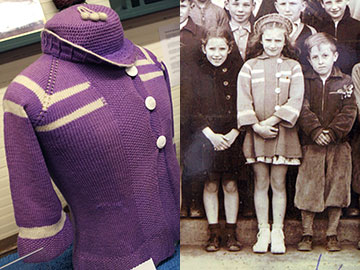
If the number of surviving objects is any indication, crochet was far more popular. In the patch bedroom, I found this nightcap displayed with the bed jacket (trimmed in filet crochet lace) it was made to match.
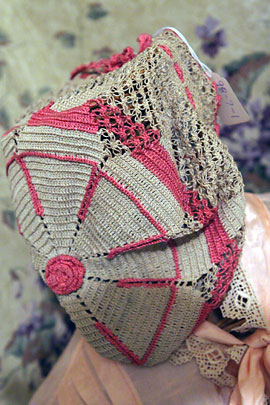
There was also a delicate pair of crochet gloves; Grandma remembers these as being reserved for extremely solemn occasions.
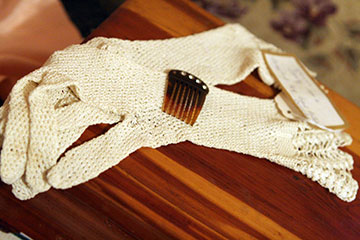
Embroidery was everywhere, worked from patterns either drawn by hand on the fabric or purchased from the local company store. Grandma says every house in the patch had one of these comb-and-brush holders over the kitchen sink–the only source of running water in the houses until after World War II.
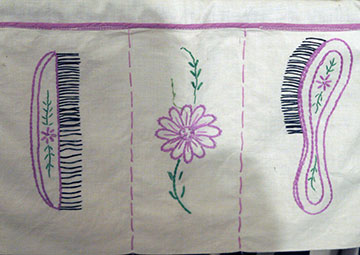
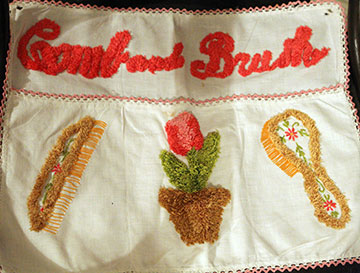
Embroidery brightened up other everyday items like bedspreads....
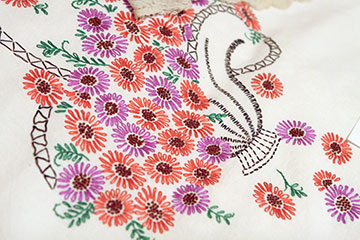
...as well as special occasion pieces like covers for the basket of food taken to church on Easter Saturday for a blessing.

This one was hard to photograph, but just like the one Grandma has (made by her mother) the florid inscription is written in Slovak.
The museum has two sets of three-panel portières. Portières hung in every home in the doorway between the kitchen and the sitting room. They were a prominent showpiece, embroidered on both sides and embellished with crochet lace and medallions.
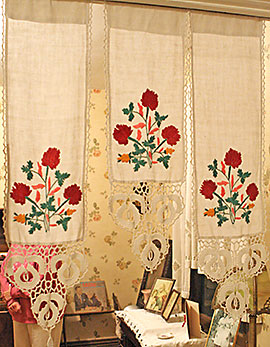
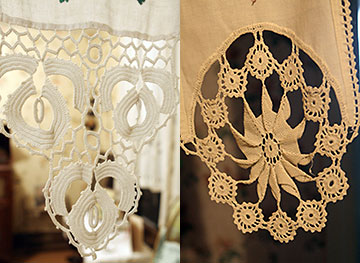
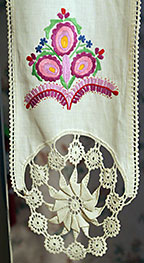 Most of the mining families in Smock (including ours) were some flavor of Eastern European. I was fascinated to see that a lot of the colors and designs were reminiscent of the folk art from that part of the world. I asked Grandma whether she knew if the commercial patterns were shipped from abroad or created domestically for the immigrant market, but she couldn't say. All she knew is that it all came from the company store.
Most of the mining families in Smock (including ours) were some flavor of Eastern European. I was fascinated to see that a lot of the colors and designs were reminiscent of the folk art from that part of the world. I asked Grandma whether she knew if the commercial patterns were shipped from abroad or created domestically for the immigrant market, but she couldn't say. All she knew is that it all came from the company store.Most households had several sets of these, and also several sets of window curtains. Both had to be taken down every month and washed, because the air pollution from coal dust, ash-paved roads, coal burning kitchen ranges, and the the adjacent coke ovens for the mine, soiled everything so quickly. It must have been an absolute nightmare to keep house under those conditions, especially using a hand-cranked washing machine or (if you weren't so lucky) a washboard and tub.
It was good to see a monument, however humble, to the people who lived and raised families in the patch. It was a hard life, at times desperately poor, but my grandmother remembers it as being on the whole not a bad way to grow up.
If you're interested in a visit, the museum has a Web site. If you go, see if you can spot my great-grandfather in the photograph of the band that used to perform at weddings and dances. Here's a hint: five of the six men are tall and the other one is shorter than the body of his bass fiddle.
Yeah, that one.
*No, I'm not going to tell you her three names. I'm a gentleman.



63 comments:
You are cheeky, aren't you? Love that Frick story.
Thank you for sharing your impressions of this museum.
How wonderful! Thank you for sharing this postcard.
Thank you, Franklin, for the loving and well told story of the Patch Museum. I hope visitors receive as apt an interpretation as you've given us.
You and I share more than an Arabic heritage.
My Slovak maternal grandfather worked in the anthracite mines in NE PA. They did not live in a company town, however. They had a wonderful house (large by comparison) on the main street across from the colliery. The house was filled with that kind of needlework. Thank you for the sentimental walk.
Namaste - Love your tribute to the workers who helped make the wealth that funded the great museums. I also studied art history in university but my interest shifted to the lives of the people responsible for the creation of the objects. (Not the rich people who took them away and put them on display.) Your response to the Frick heiress was priceless. How wonderful that the workers had colorful needlework to brighten up their homes and lives. - Joe, in Wyoming
Lovely, just lovely! And how proud your grandma must be of you! Thank you so for sharing this!
Franklin,
That was just beautiful. I expect belly laughs when I come to your blog, so this was a surprise. You've gotten me to thinking about my Grandparents, and how they, too, decorated their homes with crochet, and embroidery... and this in Central Texas. They were of German and Wendish extraction, fwiw.
You were (are!) and impertinent fella - how else to get that pic of Kaffe knitting with ecru Cascade 220! - and that's why we love you.
You inspire me. :)
(Oh, and can we have more pics of your niece? Pretty please??)
Your retort to Ms. Three Names wasn't impudent at all, it was simply the truth, which isn't said often enough!
Beautiful trip down memory lane, and it's great that the town has put the museum together.
I have a set of dresser scarves in the flower basket pattern that my mother embroidered...they were stamped patterns. Yes, I'm still using them. Thank you for this tour, maybe I'll get over there on a nice weekend.
What a wonderful glimpse of another time and place! It must have been especially interesting to be there with your grandmother. The embroidery work and lace are like many of the pieces my grandmother had. My grandmother used to tat lace -- gorgeous pieces. She's the one who taught me to embroider, but I never did learn to tat.
Wonderful post. You said just the right thing to the woman at the Frick.
Thank you for posting this, it was a real eye opener to read. We can sometimes forget how profoundly life has changed (for some, anyway) in just 1 or 2 generations.
This was amazing. I love seeing antique needlework, and your tribute to your family is wonderful. We are lucky to have some of my grandmother's pillow covers - they are traditional Russian red-and-blackwork, and I treasure them because they were made by my mother's family.
Fascinating stuff...even for someone like me with an aversion to history (except when it's brought to life in a real way for me).
I have to say, the Frick is probably my favorite museum in the World...like an oasis in NYC.
What a lovely post. Thank you, Franklin.
For my 30th birthday I went to NYC and the Frick Museum was on my list of must see. Your family history reminds me of my grandmother and the stories of the hill billies of Tazewell, TN. Thanks for sharing. Cindy
Nice. I loved reading this piece. I used to embroider stamped linen as a girl, and I can appreciate the high level of skill it takes to create these pieces.
As a history major, I've always loved local and oral histories. This is so wonderful! I grew up in open-pit copper mining country, along with a smelter - so even though the air wasn't as dirty as in coal country, we had our share - thanks so much for the history!
Growing up (which really wasn't that long ago), we all embroidered: hankies, pillow cases, tablecloths and sheets. I have a feeling that came more from my French grandmother than from my Irish one. The Irish one taught me how to knit and crochet. And we put crocheted runners on EVERYTHING, and I still have one that my Mom made on my dresser.
Thanks so much for sharing the memories. They brought a smile to my face.
My heritage is about one quarter 'round the compass to the east/northeast of Smock (45 mi. east of Pgh). My mother grew up in "Coketown" named aptly for the coke ovens where her immigrant grandparents came from Germany to work. The town was razed in the late 1940's to make way for the Johnstown floodplain project since the town was located on the Conemaugh River.
We'll have to visit Patch sometime on one of our visits 'home'. Your grandmother is probably of my mother's generation.
Though I was born in the early '50's, embroidered and crocheted fabrics like those shown in your post are a large part of my early textile memories. There was a lot of crochet and no knitting that I recall. Picking up two needles instead of a hook was one of my earliest forms of "rebellion"
...representative the '60's child that I am!
PS: I first acquired an interest in weaving while taking pottery classes at the Frick The Frick
in Pittsburgh. Looking at the website, it's improved remarkably in the past 30 yrs.
I didn't learn to weave or spin until living in the Detroit area.
Wonderful description of the museum. Thank you for sharing!
What a wonderful story! I have some of my great-grandmother's lace and crochet hooks for lace. Teeny, tiny hooks on those!!!!
Reading your story could mirror many of our family stories...my other great-great grandmother coming to the US from the Netherlands with her 17 children and living in a two room house much like the one you describe here. Thanks for adding life to it!
Thanks again, Franklin. I love these kinds of museums, that try to make the ways people lived in the past more real and vivid now. My dad's family were more farmers than miners, but a lot of your photos remind me of my grandmother's home, very much.
Thank you for sharing such vivid descriptions of your family, Smock, and their handiwork (and your cheeky response -- loved it). I was surprised though -- no comments on the "Franklin Club House Rules" posted on the museum's site?
Great post- I love the Frick Collection and love your riposte even more -- my grandparents were servants in those homes, and I always look around and try to imagine it from their perspective. Next time I'm there I'll remember the hands digging the coal and drilling the oil.
Thanks for sharing the moment with the Frick tour guide. Many of us only think of clever responses after the fact. Yay for quick wit.
Knowing the effort involved in making beautiful everyday objects, it's wonderful to see their preservation because in some way this also keeps alive the stories of the people who made them. My family was interned during WWII and were only allowed to take whatever they could carry with them. Having only 2 days to leave a household worth of things somehow my grandmother chose to take one of the first dresses she made for my oldest aunt. My grandmother didn't knit but her hand sewing was so beautifully accomplished.
What a great way to connect with your family and ancestors. It is so exciting to see all that needlework, especially the knitted coat. Purple!
What a beautiful post. I always love your posts on your family. Thank you for sharing them with us.
I am absolutely crushed that I will not be able to attend the 1000 knitters shoot in Sacramento. (I'll be visiting *my* family.) I am not a knitter, but you are one of my blog heroes, and I can NOT believe I'm going to miss your visit out here. Hope you have a lovely time.
Thanks so much for the social history as well as the personal. Very special. Gives us a lot of perspective on a tough but viable life. We are outrageously privileged and spoiled.
Love the Frick comment! Good thing she took it well.
Your grandmother must have been blown away to be back in Smock. And you must have been blown away to be there with her. Thanks for the tour. It was lovely. :)
That's a lovely tribute. The miner's house sounds not unlike the sharecropper's cabin my great-grandmother lived in - a front porch, a tiny living room dominated by a massive oil heater, a similarly tiny bedroom, and a galley kitchen in back that had the only running water in the house. The "necessary" was an outhouse in the pasture behind the house, with a sort of stile in the fence to provide easy access but keep the cows from escaping.
Hi Franklin. I've mostly lurked, but this wonderful post of yours has made me come out and say thanks for a touching, thoughful view into your family's past. Your blog is always entertaining but this post is special.
thankyou Franklin. may i say your blog today is worthy of Piecework. thanks for sharing, i'm SO going to try to copy that crochet hat. love the love knot stich.
Franklin, thank you for this! My Grandma passed away last year, and we are still going through the bags and bags of needlework -- crochet and embroidery, mostly. I have loved looking at her work and seeing the bright touches to her house, and I love hearing about others' work too. Great post.
My father and his father (maybe even farther back) were coal miners in WVa and while I didn't grow up in a coal town, many of my friends did and I visited them. It was just as you describe. Have you seen the movie 'October Sky'? It's a very close depiction of a coal mining town in WVa.
Amazing! Thank you for sharing this museum with us. (Fourteen children! {swoon, faint})
BTW, I'm currently an PhD student in the Henry Clay Frick Department of the History of Art and Architecture. Talk to me about the number of stories about "crazy old" Miss Frick there are! (Different old lady Frick than yours, I know.) I applaud your impudence. ;)
I had to read the entire story to find out the name of the town, as you have described the mine house at Beckely, WVa almost to a T. My grandfather and his brother worked at the Kaymore mine in the New River Gorge area of WVa (pretty much right under the bridge), not in the mine, but as a telegrapher and company store manager, respectively. My cousin Leland told us stories about the mine wars and the riots in the towns between the owners and miners.
Thank you for sharing!
My grandpa worked in the coal mines in Colorado and Idaho when he was young (he spent most of his life as a plasterer). I love family history, mine and other peoples.
My mother's people are all Slovak, and I have some embroidered pieces from my aunts that resemble that one! My G-GF was the one who came over from Slovakia, and the family settled in St. Louis Missouri. Smock is in Pennsylvania, then?
Franklin you made me weep. This is exactly the way my parents described their lives in a coal mining town in SW VA. When they moved to the city they lived in a mill workers 'camp' for a while.
The mill workers houses were one room bigger they had a living room, kitchen and two minute bedrooms plus a front porch.
Another wonderful post, Franklin! Thank you so much!
I miss my grandmother terribly. She was the knitter in our family, and she passed away over 15 years ago [long before I took up the needles myself.]
I'm working hard on my Dolores look-a-like entry. I have procured the highly-cooperative sheep and am working on accessorizing. Accessories are very important, Dolores would tell you.
What a beautiful post. I always enjoy your blog, but this post was especially moving. I'm a fairly new PA resident, and it was great to learn a little more about the cultural history of the state. Thanks!
Amazing post, Franklin. What stories those beautiful handmade pieces tell. It's quite a testament to the people of Smock that, crowded and hardscrabble as their lives were by modern standards, they still created those works of art.
And I too love the Frick story. Good for you, and good for Henry's great-granddaughter.
Fascinating. Truly.
Gorgeous history. I used to live across from the Frick mansion in Pittsburgh, my friends even got married at the gallery. Your connection is beautiful!
I do love these unique insights into that world
What a wonderful post, and a terrific museum. I love the way it sounds like it was put together with love and respect for those beautiful objects that brighten up daily life, especially humble daily life. Those boy scouts did a great job.
I hope you're recording your grandmother's memories in some fashion. Luckily, my mother was able to record many of my grandparents stories before they passed away. Amazing what they experienced.
kisses to your Gran! what a lovely woman to share this with you--and, so, all of us
Impudent, maybe, but you were just being honest.
Have you seen this? http://www.unshelved.com/archive.aspx?strip=20071028
Franklin, I feel as though I've been given a gift. I WILL get to that Museum, I will. If I had the chance for a cup of tea with your grandmother and some of her stories of childhood I'd drop everything and run. I'm just WILD about all such things (helps me, as a Museum guide in our Historical Museum and a Fur Trade Reenactor). Please, when you see her again, give Grandma a tiny kiss on her cheek for a damp-eyed bubbe in Wisconsin who thinks she's beautiful and is grateful to her...for you, too.
I found this post really interesting because my father is from Filbert and I believe I have family in Smock (and other those teeny tiny towns in SW PA). I'll have to check out that museum next time I'm down visiting family. My grandfather was also a coal miner. And I have some of my grandmother's embroidery--pillow cases, dresser scarves, etc. Wish I could get one of her quilts too.
The coal mines of Pennsylvania. I'm the last scion of the town of Centralia of mine fire fame. Always a pleasure to learn of another hunkie from the coal fields.
Oh, the comic I linked to earlier might not make sense now (in context) because he edited the "Panopticon" out. http://www.unshelved.com/blog.aspx?post=915 explains why.
Wow.what a wonderfully interesting place to visit, and even more so with the family connection. Your grandmother sounds lovely.
Wonderful blog Franklin. Thank you. Coincidence - sitting beside my computer waiting for blog recognition is a little booklet of poems written by my grandmother in the 1920's - reading your blog this morning reminds me that I really must pay my dues to her as you have done in the lovely tribute to your grands.
What a wonderful way to pay homage to your heritage and your Grand Parents.
I live in central Pa and the area is surrounded by coal mines. I enjoy the history, and the glimpses into the daily life.
Hey, I found your blog though Ravelry, and that story you told about learning to knit in prison. ;-) I clicked to the most recent entry, and just wanted to comment.
I have to say that this post brought tears to my eyes. I'm the great-granddaughter of coal-mining Slovak immigrants, only mine were in a small town in Ohio which literally doesn't exist anymore. Our Slovak heritage was all but erased as the great-grandparents were determined to assimilate into the US and only allowed their children to speak English. I grew up with an almost unpronounceable last name with no idea where it came from.
There's an interesting novel by Thomas Bell called Out of this Furnace, which is about a Slovak family and immigrant labor in America. It's a pretty good read, and gave me further appreciation of what my ancestors did for me
Anyway, just wanted to let you know how much I enjoyed reading your post. Take care!
jeneralee on Ravelry
You know, your photography has really come a long way, baby. *smooch*
Franklin, when your grandmother tells you these stories, are you taking notes?
The reason I ask is that the last 3 years of my grandmother's life, I was taking care of her, and she told me all kinds of stories about her living in Africa and cooking on a bush stove, and living in Jamaica, and what that was like, and I didn't write them down...I thought she was going to be around for a while. She got lung cancer and died 5 weeks after diagnosis in 1989, and I am so sorry I didn't write her life down for her, and for me and my children.
If you don't record the stories, you will regret it later.
I love your impudence.If your guide was Martha Frick Symington Sanger, I think she is well enough known to mention her name. She wrote a book that is a photographic monument to the houses of her great grandfather:
The Henry Clay Frick Houses
Post a Comment